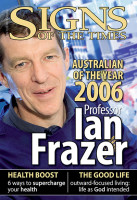From our earliest days on the playground we have been choosing sides. Glenis Lindley explores the human compulsion to align ourselves with a group and stick by them through thick and thin.
Some people derive a great deal of pleasure and a feeling of wellbeing by belonging to a church, a club, community group, company or particular culture. Perhaps it's part of our inbuilt make-up—wanting to feel accepted, wanting to be like our friends.
A similar experience happens within the world of car ownership and brand acknowledgement. In Australia—for reasons not entirely understood—many of us seem to have our own leanings toward either Holden or Ford cars.
If someone within our family had a close affiliation with one or other manufacturer, that often tends to influence our loyalty in later life. Even though we ourselves (because of varying circumstances) may drive a different manufacturer's model now, our deep-seated love of “Red or Blue” remains.
Delving back in history we learn that Ford cars were manufactured in America by Henry Ford, whose Model T became the benchmark more than a century ago, while the first Holden rolled off the assembly line in Victoria in 1948.
At this significantly important occasion, Prime Minister Ben Chifley was called upon to launched the “local” car.
The Holden tradition was started by Holden's Motor Body Builders, which later became General Motors Holden's (GM-H). The first Holden, a 48-215 (popularly called FX) was billed as “Australia's own car,” built for Australians by Australians, which could account for its enormous popularity.
Aussie patriotism, in the Red or Blue tradition—Holden versus Ford—is particularly noticeable in October when thousands of fans flock to Mount Panorama to watch their sporting heroes, legends, champions, doing battle in Australia's most prestigious motor race, the Bathurst 1000. As millions more watch on television, throughout the nation this “great race” grips the public imagination. It seems Bathurst is not just a race—it's become a way of life! Rightly or wrongly, fans are obsessed with Holden versus Ford—a form of tribal warfare more than 40 years old.
It all started with the stars of yesteryear (acclaimed mountain-men like Peter Brock and Allan Moffat) soaking up the limelight as Holden and Ford drivers went head to head trying to claim the honour and glory of conquering the mountain (and the opposition).
In previous years, several other manufacturers also participated, but currently V8 Supercar racing at Bathurst is restricted to Holdens and Fords, adding fuel to the fire and perpetuating the “battle of the badge”—the lion versus the blue oval.
Current five-time Bathurst winner Mark Skaife describes the spectacle: “Even when I was a little bloke, I used to get up at seven in the morning [to watch Bathurst]. It was like Christmas—you couldn't sleep! “ "The tradition, the track and the people combine to make it the race of the year,” Skaife concludes. Crowd numbers continue to increase along with the popularity of this style of racing that has become more family-oriented, with more and more female fans attending, or glued to TV sets throughout the day.
Most Holden versus Ford rivalry is friendly, but passionate. However, our emotions sometimes sadly take control and bitter clashes have resulted on occasions.
The ugly, ocker image is gradually disappearing, as race fans come to appreciate the high level of professionalism involved and respect the dedication of the drivers.
What makes this annual pilgrimage to the mountain—for avid fans and drivers alike—so special? It is every driver's dream to compete at Bathurst and it's every driver's ambition to win this prestigious endurance classic. Unquestionably a crowd favourite, it's also phenomenally successful, the pinnacle of V8 Supercar racing and the toughest test for man and machine. Not only is the Bathurst 1000 a household name in Australia, widespread recognition in international circles has raised the bar considerably.
The magic that is Bathurst, the annual ritual petrol dance around the mountain has produced tears, elation, heartache, anger, frustration and disappointment; monumental crashes and record-breaking performances—and all that from the drivers! Devout fans, too, have a similar set of emotional extremes.
Come race day it's not difficult to see which side fans support. Followers of Team Red are decked out in red T-shirts, caps, jackets, adorned with other assorted merchandise and wave lion-emblem flags, while the Blue Oval Brigade proudly wear blue and white attire and carry Ford banners and flags.
Ironically, team and car loyalty isn't such a big issue for professional drivers, whose motivation is about making money and winning races and titles.
While a minority of drivers may have only driven for one team, most have raced both brands. Even stalwarts, Allan Moffat and Peter Brock have switched to the opposition on occasions and even co-driven a Holden together on one occasion.
In more recent times the first major defection by a top-ranked driver occurred in 2001 when budding new “Holden hero” Craig Lowndes switched to Ford (Gibson Motor Sport). Holden's superstar and former golden boy had committed the “unpardonable sin” in the eyes of his devastated fans. He was branded a traitor, even received hate mail, but while he lost many loyal Holden followers, he soon gained a new band of dedicated Ford devotees.
“It was a tough decision to make, but I'm looking forward to beating my old team-mate [Mark Skaife] in a Ford,” said the likeable Lowndes, who has driven for several Ford teams since then. His road proved rocky and his goals haven't been met, nor has the man who once seemed unbeatable, claimed any titles, but he's knocking on the door.
To his credit, he hasn't lost his smile! Of interest, another respected Ford driver and triple Bathurst winner, Dick Johnson, started his career racing an FJ Holden. The ageless master “Gentleman” Jim Richards, a seven-time Bathurst winner, has driven everything from Hillman Imp to Holden (although the love of his life is Porsche).
So why do such rivalries develop? Perhaps it's to do with a deeper human need—loyalty, community, holding a particular belief (red or blue, believer or atheist, Labour or Liberal). It's about forming social groups and being strengthened by emotional bonds. It's a personal statement of what we value and identifies to which community we belong. We choose sides because we want to belong.
In this instance, attempting to determine which is the better brand is pointless.
There have been good and bad models from both manufacturers. But those who hold a firm belief that Holden or Ford—choose your favourite—is best will usually stay faithful to that belief.
Often, even peer pressure can't sway them. Many fans, families and church communities will always remain true to their cause as “blest be the tie that binds.” n Call it being one-eyed, biased or bigoted, the pattern plays out in supporters of different football teams, codes, nations, nationalities, religions, denominations, families and innumerable other communities. Along with these passionate allegiances often come fierce reactions to those who hold differing views. People just can't imagine anyone not sharing their belief.
There's little logic to arguments put forward by some diehard Ford or Holden supporters as to why one is better than the other. Taking cars out of the equation, it's to do with attitudes that make us feel stronger, more spiritual. By constantly “knocking” our competitors— the other brand—subconsciously we strengthen our own belief.
Dr Jason Pudsey, from Flinders University, Faculty of Social Sciences, has a good slant on brand rivalry, describing it as what sociologists call “secular religion.” “We need another to know ourselves.
Every ‘us' needs a ‘them,'” says Dr Pudsey.
“Given the competitive nature of racing, much like war, every victory or loss reinforces our sense of solidarity with our tribe and the animosity of the enemy.” n So, are Holdens or Fords better? Since 1963, Holden victories at Bathurst tally 25, while Ford have only 14 on the board. The last 10 years have not been good for “blue oval” supporters, with only one win to boost morale. But irrespective, they remain true to their cause.
Other sports have their Red or Blue too. The State of Origin Series is one example—the annual National Rugby League clash between Queensland (Maroons) and New South Wales (Blues). Emotions run high! There's always a good mix of euphoria matched with controversy when fans barrack for their special team.
The games are watched live, on big screens, at BBQs and dinner parties, in homes and clubs. The intensity of emotional feelings over clashes such as this result in careful rehashing the next day at school, in offices and on work sites.
This is emotional sport, where even lounge-lizards become involved in heated debates!
Much of our lives are given over to the group—whether it be a sporting team, a make or model, a religious community or the family values by which we were raised. We thrive when we belong.
One of the greatest fears we experience in life is the fear of loneliness. We do all we can to avoid being isolated, ignored or rejected. Happiness is partly in picking the right team to barrack for, the right colour to support or the right church to attend.
But, ultimately, the successful life is one that added value to something that will live on when we are gone—and that begins with finding something in which we can truly believe.




